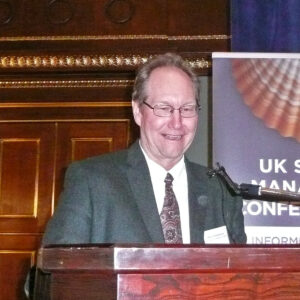Tim Oliver reports on a two-day international conference, held in London, to find answers to the problems in the UK scallop sector
The organisers of an international conference on the management of the UK scallop sector said they were ‘thrilled’ by how the event had gone, and that they had received ‘very positive’ feedback.
The conference was held to highlight the problems facing the scallop sector, and to hear from other countries about how they managed their scallop fisheries, in the hope that their approaches could provide insights and ideas to take forward and improve management in the UK.

Delegates heard presentations on scallop management from the Isle of Man and Shetland in the UK, and from France, Canada, the USA, Argentina and New Zealand.
Common themes that ran through the presentations and debates were the need for better science to support better scallop stock assessments, and therefore management; a need to reduce capacity, to ensure sustainable fishing and improve profitability; pressures from the environmental movement, and on fishing grounds from MPAs, wind farms, etc; and the need for a coherent overall UK plan to replace the current patchwork of regulations in different areas and administrations.
The conference was organised by Macduff Shellfish in conjunction with the Fishmongers’ Company, and was held in the prestigious Fishmongers’ Hall in London.
As well as presentations from UK organisations, fishery managers and scientists, speakers from France, Canada, the USA, Argentina and New Zealand described how some of their scallop fisheries were managed, both onshore and offshore.
Brexit will give the UK a once-in-a-generation opportunity to introduce far-reaching changes to fisheries management in all sectors, including scallops, as the new fisheries bill to enable these changes goes through parliament.
Hazel Curtis, who led the Seafish economics team until recently and who, among her other high-level roles, is independent chair of the project steering board of the English Waters King Scallop Assessment Project, highlighted the problems facing the UK scallop sector.
She said that the current management model was not working, and that the sector needed to reduce capacity. Catches had to be restricted to conserve stocks for the future, or ‘it won’t end well’. Profitability was going down, and numbers of vessels were rising, as more vessels switched to the scallop sector because of the reduced catching opportunities in other fisheries.
She said that there is no overall management plan or landings limit, just a series of different rules and restrictions in different areas that limit inputs into the fisheries, but not outputs. Vessels need viable amounts to catch, future certainty to encourage investment, good access to markets and good prices, and a stable number of profitable vessels.

Speakers in a question and answer session, left to right: Claire Pescod, Marine Stewardship Council; Dr Beth Mouat, chair, Shetland Shellfish Management Organisation; Alan d’Entremont, president, Full Bay Scallop Association, Nova Scotia; Dr David Beard, chief executive, Manx FPO; Servane Le Calvez, Mission Environnement, Cotes d’Armor, Saint-Brieuc, France.
Catch rates had been falling gradually, no matter how the data was analysed, and operating costs were rising faster than revenue. It was only the fact that prices had been good, and rising quite strongly in recent years, that had kept the sector viable.
She also stressed the need for better science and stock assessments to agree sustainable harvest levels, because decisions on catching opportunities depended on knowing the size of the stocks.
Stocks had to be protected by restricting catches, and tradeable fishing rights might be one way to do this – but they had to be managed differently from the existing FQA system of whitefish quotas.
The sector needed certainty – apart from Brexit considerations. There is currently uncertainty over the size of stocks, catching opportunities, and the number of vessels in the fishery. “We don’t know the size of the pie, or the size of the individual shares of the pie,” she said.
She said that management was better when the industry was involved, and that there wouldn’t be better outcomes without change.
Jim Portus, chairman of the Scallop Industry Consultation Group (SICG), said that he wanted the conference to be a success, and that the scallop sector had to be ambitious, but not too ambitious – or it would produce a ‘wish list’ of unachievable proposals that would just be shelved.
He said that if it were not for strong scallop prices, the industry would be in crisis.
He outlined the many restrictions on scallop fishing, through such things as MPAs, iVMS, permits and potting separation agreements. But while the current management regime was ‘chaotic’, there was no ‘one size fits all’ answer. Action was needed now to develop a good management system to protect stocks and the ecosystem, to resolve mobile and static gear conflicts, and to ensure long-term economic benefits.
“There are real risks, and if productivity goes down, we will have failed – success must be our legacy,” he told the conference.
Electronic polling

Answering questions from the floor, left to right: Dr Lynda Blackadder, Marine Scotland Science and chair of the ICES scallop stock assessment working group; Hazel Curtis, Seafish and English Waters King Scallop Stock Assessment Project; Jim Portus, SWFPO and chair of SICG.
The conference used an electronic polling system to assess the views of the delegates at the conference on a range of discussion topics.
There was very strong support for differentiating between inshore and offshore management regimes, and for the view that the management system must be revised. There was also a strong ‘no’ when delegates were asked whether they had enough information to make decisions in their fisheries.
Major concerns of delegates were to ensure scallop fisheries remained sustainable, and the effects of displacement of effort into the fishery, caused by reducing opportunities in other fisheries.
There was also a lot of concern in the sector about the possible impact on scallop exports to the EU after Brexit, particularly if the UK leaves without a deal.
There was also a roundup of views from each table at the end of each session, which produced views on a range of topics. There was a general view that better science is needed, and that the sector must agree on what its objectives are, particularly in terms of matching effort to resources. It was recognised that there is no single solution for the whole fishery.
Licences would have to be frozen, or even removed, to curb capacity and limit access to the fishery, and ‘technical creep’ also needed to be brought into the equation.
Introducing quotas was a possible way to manage the sector, with possible community ownership of quotas.
Co-management of the sector by the industry with the authorities was seen as important, as was greater involvement of scallop vessels in data gathering.
Displacement

Alan d’Entremont, president of the Full Bay Scallop Association, Nova Scotia – “Stocks kept at high levels.”
Displacement effects were a cause of concern, and it was pointed out that some vessels in the sector are 100% dependent on scallops.
Delegates pointed out that reduction of catching capacity would inevitably mean there would be ‘winners’ and ‘losers’ – those who were able to continue in the scallop fishery, and those who had to leave.
The usual method of allocating fishing rights was through track records in the fishery, but there were other ways to do this. But whatever method was devised to determine who could stay in the fishery, it would be necessary to find ways to enable those who had to leave to sell their rights to those who remained. This was ‘a really crucial question’.
It was suggested that tradeable fishing rights were one possible way in which the fishery could be managed, but it was stressed that lessons had to be learned from the way the system operated in the whitefish sector, to avoid concentration in too few hands.
This led to debate on how to manage displacement of effort. It was pointed out that the problems in the scallop sector arose, to a large extent, because effort had been displaced into the fishery from other more tightly regulated fisheries, as catching opportunities in those fisheries reduced.
If the scallop sector became more tightly regulated and fishing opportunities and capacity were reduced, this fishing effort would be displaced to other fisheries, putting pressure on them in turn. Similar effects had been seen in the shellfish and whelk fisheries.
Management of the scallop sector could not be looked at in isolation from overall fisheries management.
Science

Jim Portus, chair of the Scallop Industry Consultation Group – “Curb influence of scallop sector detractors.”
The conference discussed the need to improve the scientific assessment of stocks, but also the difficulties of achieving this, and the need for more resources.
Scallop aggregations were numerous and occurred over huge sea areas, and it was not possible to assess every single scallop stock. Scallop stock assessments were also more difficult than those for whitefish, because they tended to have strong recruitment ‘spikes’ every five or 10 years.
Marine Scotland scientist Lynda Blackadder, who is chair of the ICES Scallop Working Group, said that more collaboration was needed between scientists and the industry. It was pointed out that scallop surveys were taking place in the English and Bristol Channels and in the North Sea, with the charters of the vessels involved being funded by the scallop sector. This was ‘a new way of doing science in the UK’, said Hazel Curtis.
Jim Portus said that the industry now recognised the need for better data for stock assessments, but it was ‘a few years behind the curve’, and he wished it had stepped up earlier.
Lynda Blackadder said there were not the money or resources to devote to more scallop assessments, and that they were forced to prioritise.
It was stressed that action is urgently needed to protect stocks. It could not be put off until better data and stock assessments were available, which would take a long time. Using the ‘precautionary approach’ would be a good first step.
Environment

Professor Kevin Stokesbury of the University of Massachusetts explained the successful management of the US Georges Bank scallop fishery.
The conference also considered the pressures on the scallop fishery from environmentalists, who complain that dredging can never be a sustainable fishing method because it damages the seabed and marine flora and fauna.
It was pointed out that some opponents of dredging, and some consumers, argued that scallops should only be hand-caught by divers. Consumer concerns could be addressed by applying for MSC accreditation, and by reducing the ‘footprint’ of the fishery.
Jim Portus said that the sector must ensure that habitats are protected, and that stocks are sustainable, and that the scallop sector’s detractors should not be allowed to have too much influence on policies and management. The industry’s responses to them should be ‘proportionate’ and ‘appropriate’. He also pointed out that fishermen will move away from scallop areas when they become uneconomic to fish, rather than when they are biologically fished out.
A working group of the SICG was due to meet very soon after the conference, to discuss the ideas and views raised, and how they could be taken forward to develop a new management regime for the sector.
Event organisers: ‘Very positive feedback’
The conference organisers said they were ‘thrilled’ with how the event turned out, and that feedback had been ‘very positive’.
A spokesperson said: “We achieved clear consensus, from delegates and experts from a wide range of stakeholders, on the need for change. The conference significantly advanced the discussion on potential management approaches, including inshore and offshore management, freezing latent capacity, and the exploration of TAC and rights-based systems.
“There is clearly a lot of work ahead for the UK industry, but we are encouraged by the desire for co-management of these valuable fisheries and collaborative evidence-gathering initiatives. It is important that progress is made now. Scallops are the third most economically important stock in UK waters, and the most important in English waters.
“As we face a change in fisheries management arrangements through Brexit, the removal of the CFP and a new fisheries bill, the opportunity to initiate change is now.”
The spokesperson said that the scallop sector will now be looking to advance the discussions with government, and to build momentum and alignment among stakeholders through the Scallop Industry Consultation Group and other industry forums over the course of the year.
‘Good sustainable future is achievable’

Professor Oscar Iribarne, director of Argentina’s Institute of Marine and Coastal Research, gave a presentation on the offshore Patagonian scallop fishery.
Speakers and delegates had positive views of the benefits of the conference. They thought it had delivered a thorough discussion of the various problems the scallop sector faces, and had suggested a range of possible ways to address these in the future.
Jim Portus, chairman of the Scallop Industry Consultation Group (SICG), said he was convinced there was a good sustainable future for the scallop sector, although it might need ‘heads knocking together’ to achieve.
He said he was very pleased that a lot of things said at the conference had been said in the past, something that one of the keynote speakers had reflected on.
“If you’re not coming up with any surprises, then we should be able to pull all of those threads together into some form of a management process quite quickly, and it will be an informed process that shouldn’t have too many people objecting to what we come up with.
“I’m involved in the SICG management group, and we’re meeting for the first time next week – and now we’ve got some really good clues that have been given to us over the past two days.”
Jim Portus welcomed the passion for the industry that the conference had revealed, although he said it had not really surprised him, because the industry was economically important and produced a lot of jobs in a lot of fishing communities.
“It was good to see so many people from the fishing industry at the conference – that’s most unusual,” he said.
“I’ve been to loads of conferences over the past 30 years, and quite often, I’m the only person who can legitimately claim to be from the industry. But the way that Juliette (Hatchman, of Macduff Shellfish) organised it so that we had a really good cross-section of people from the industry, from all over the UK, was a very clever device to make sure that we got their views, and I hope that they’ve been captured.”
He said he was ‘convinced’ that a sustainable future was going to happen. “It’s going to be difficult – it’s like herding cats. We’re going to have to knock some heads together in order to achieve some changes of entrenched views – but I’m looking forward to the meetings of the management working group, and presenting some ideas to the industry through the SICG.
“But crucially, we’ve also got to make sure that DEFRA, Marine Scotland and all the devolved administrations are willing to enact and enable the processes and procedures that we want to be put in place.”
Professor Kevin Stokesbury (US Georges Bank sea scallop fishery and University of Massachusetts) and Alan Reeves (fishery manager, Georges Bank sea scallop fishery) gave presentations on the US and Canadian scallop fisheries on Georges Bank.
Professor Stokesbury said he believed that getting good stock assessments was key to the future, and Alan Reeves said the key ingredient for him would be for the industry and regulators to work together – a theme throughout the debate.
Professor Stokesbury said he thought the conference had been effective, with a good mix of economics and science. “I thought some of the case studies were very good. I think it’s a very tricky question with the UK, and the conference set the stage for how tricky it is – it showed the different complexities. I’m sure that people are, at least, now thinking about different ways to go at it.”
Asked if he was hopeful that the UK could have a sustainable scallop fishery, after listening to the presentations and debates, he said, “I think so, but I think you’ve got to get that stock assessment squared away. That’s the key, and before you go too far down the path. It’s a lot easier once you know what you have, and where it is, and what you’re dealing with.”
Alan Reeves said he had not been really surprised by anything he had heard at the conference. “In Canada we’ve certainly seen a similar situation decades ago, and how it evolved there compared to where it’s at here – so that was very interesting to me.
“It’s fairly hard to research this fishery – there’s not a whole lot of information available that I could find out there, so it was very enlightening in that respect.
“If there is one key ingredient to improving the situation in the UK, I would say – and it’s been a theme throughout – it’s that the regulators and the industry have to work together. It just doesn’t work any other way effectively. The key thing is to find solutions that are meaningful to everyone.”
Bryce Stewart from the University of York said it had been great to get a real diversity of scientists, stakeholders and managers together, and to share the problems, but also the possibilities for the future.
“I think what’s been really interesting is looking at the examples from overseas and seeing what’s possible – but also realising that although those systems look really good, they haven’t come without a bit of pain as well. So it’s ‘no pain, no gain’ in this situation, unfortunately.”
But he said he was ‘cautiously optimistic’ that the scallop sector could develop a sustainable future, although there was a long way to go.
“We’ve evidence that there’s overcapacity in the fleet. In many areas, stock levels are down quite low; it’s probably quite an inefficient industry as it stands. So there are a lot of changes that need to be made, but at the same time, the fact that we are all together here shows that there is a will to produce a better future.”








